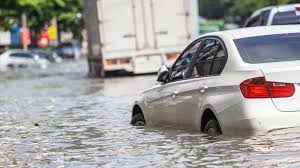Recent floods in South Florida left many cars stranded, including numerous electric vehicles (EVs). This occurrence raises concerns about the safety of EVs in such conditions.
Traditional gas engines, which rely on air and fuel, can be seriously damaged by water ingress. Electric vehicles, on the other hand, are designed with seals to protect their batteries and electronic systems. However, these seals can degrade over time, leading to potential leaks, according to Jonathan Sanchez, lead supervisor at EV Garage Miami.
The Cost of Water Damage
Sanchez, who has experience with both gas-powered and electric vehicles, stated that water damage repairs could be cheaper for EVs if you’re fortunate. Traditional combustion engines have complex parts that can take a considerable amount of time and money to repair, often costing upwards of $10,000.
In some cases, water-damaged EVs can be fixed by removing and drying the battery, similar to how one might handle a waterlogged cell phone. Sanchez estimates that this process would take about an hour and cost approximately $500 at his garage.
However, if water penetrates too far into the battery, it can result in catastrophic failure, leading to a hefty repair bill of around $18,000.
After the recent floods, several vehicles were brought into EV Garage Miami for repairs. Thankfully, none of them suffered catastrophic battery damage. Instead, the most common issues were panels falling off, water-damaged carpets, and torn bumper covers due to driving through heavy water.
Vehicle Water Resistance
Some companies, such as Tesla, claim their vehicles are more robust against water damage. Elon Musk, for example, stated that the Tesla Cybertruck should be able to briefly cross rivers and even seas that are not too choppy.
Despite these claims, even a Cybertruck was seen being towed out of South Florida floodwaters this week. According to the National Weather Service, six inches of water can reach the bottom of most passenger cars, and a foot of water can stall most vehicles, regardless of whether they are electric or not.
False Perceptions About EVs and Water Resistance
Brent Gruber of JD Power, a data analytics company, has sought to dispel the misconception that EVs can safely drive through floodwaters. The notion gained traction following a viral video showing a Tesla navigating a flooded street in San Diego.
Damaging to vehicles is almost inevitable when they are driven through deep, standing water. “I cringe when I see the videos because it damages the vehicle,” Gruber said.
Research conducted by the National Highway Traffic Safety Administration and the Idaho National Laboratory after Hurricane Ian in 2022 found that between 3,000 to 5,000 EVs were damaged. Among them were 600 total losses and about 36 that caught on fire. Salt or brackish water, which erodes cars, was the primary cause.
“EVs are designed to operate safely in the rain but they are not designed to be boats,” Gruber said, reiterating the importance of avoiding driving in flooded areas.
Original Story at www.miamiherald.com
